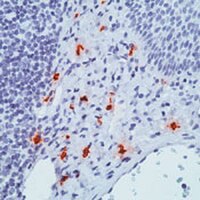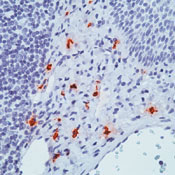444905 Sigma-AldrichAnti-Mast Cell Tryptase Mouse mAb (AA1)
This Anti-Mast Cell Tryptase Mouse mAb (AA1) is validated for use in Frozen Sections, Immunoblotting, Paraffin Sections for the detection of Mast Cell Tryptase.
More>> This Anti-Mast Cell Tryptase Mouse mAb (AA1) is validated for use in Frozen Sections, Immunoblotting, Paraffin Sections for the detection of Mast Cell Tryptase. Less<<お勧めの製品
概要
| Replacement Information |
|---|
主要スペック表
| Species Reactivity | Host | Antibody Type |
|---|---|---|
| Ca, Fe, H, Mk | M | Monoclonal Antibody |
価格&在庫状況
| カタログ番号 | 在庫状況 | 包装 | Qty/Pk | 価格 | 数量 | |
|---|---|---|---|---|---|---|
| 444905-100UGCN |
|
樹脂アンプル | 100 μg |
|
— |
| Product Information | |
|---|---|
| Form | Liquid |
| Formulation | In 10 mM PBS, pH 7.4. |
| Positive control | Cat, dog, human, or monkey mast cells |
| Preservative | None |
| Quality Level | MQ100 |
| Physicochemical Information |
|---|
| Dimensions |
|---|
| Materials Information |
|---|
| Toxicological Information |
|---|
| Safety Information according to GHS |
|---|
| Safety Information |
|---|
| Product Usage Statements |
|---|
| Packaging Information |
|---|
| Transport Information |
|---|
| Supplemental Information |
|---|
| Specifications |
|---|
| Global Trade Item Number | |
|---|---|
| カタログ番号 | GTIN |
| 444905-100UGCN | 04055977186208 |
Documentation
Anti-Mast Cell Tryptase Mouse mAb (AA1) (M)SDS
| タイトル |
|---|
Anti-Mast Cell Tryptase Mouse mAb (AA1) 試験成績書(CoA)
| タイトル | ロット番号 |
|---|---|
| 444905 |
参考資料
| 参考資料の概要 |
|---|
| Sommerhoff, C.P., et al. 2000. Biochim. Biophys. Acta.1477, 75. Little, S.S., and Johnson, D.A. 1995. Biochem. J. 307, 341. Morgan, S.J., et al. 1991. J. Allergy Clin. Immunol. 87, 111. Walls, A.F., et al. 1990. J. Pathol. 162, 119. Wall, A.F., et al. 1990. Clin. Exp. Allergy 20, 581. |

















